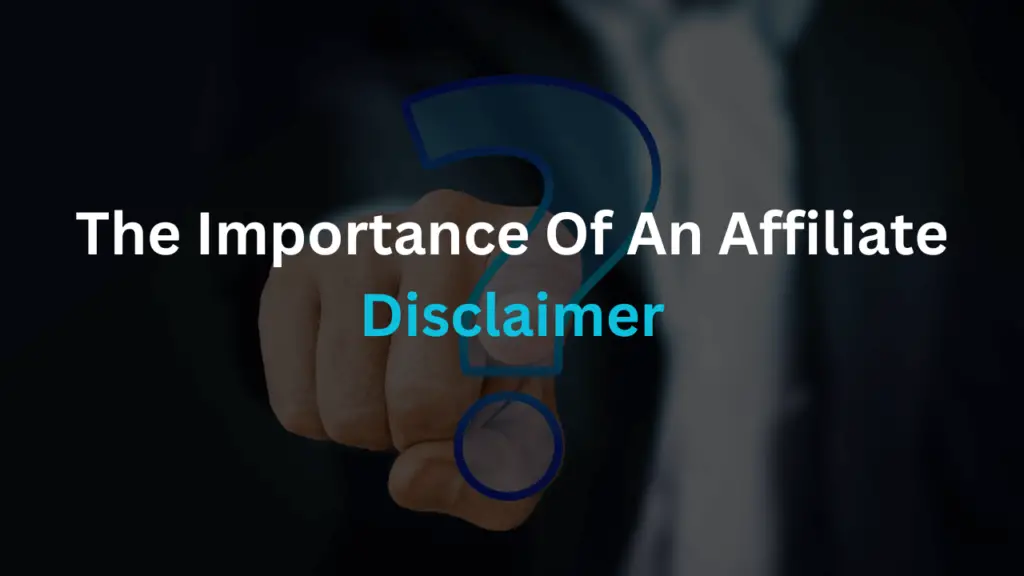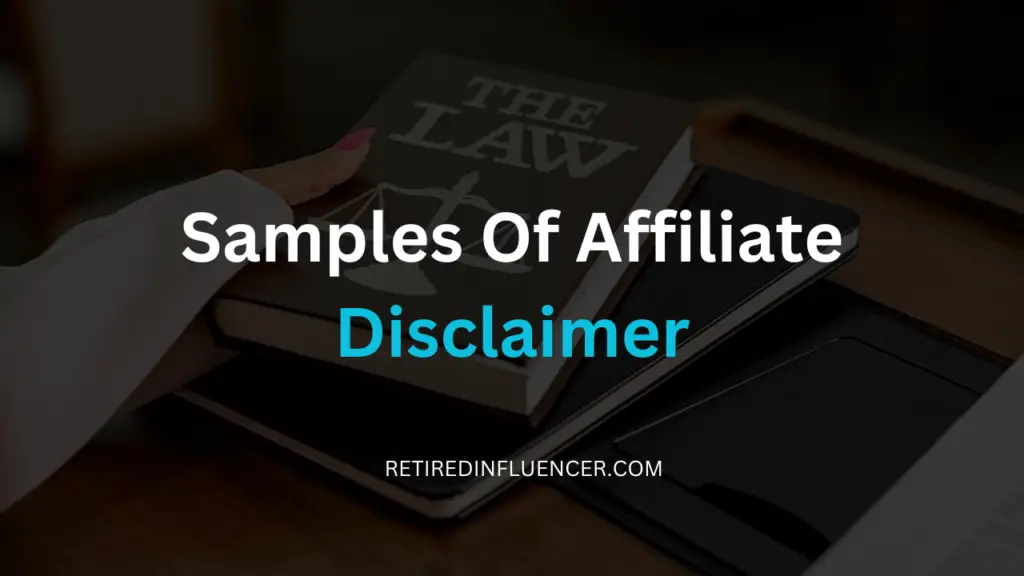In the digital marketing world, understanding the role of an affiliate disclaimer is not just a legal necessity but key to building trust and credibility with your audience.
The primary key of disclaimers is to reveal transparency and the financial relationships between content creators or online marketers and the products or services they endorse.
That said, let’s take a look at the significance of these disclaimers in affiliate marketing and why implementing them in your marketing effort is crucial for your success.
Table of Contents
What Is An Affiliate Disclaimer?
An affiliate disclaimer is a transparent disclosure provided by content creators, online marketers, or influencers to inform their audiences or customers about any financial relationships or partnerships with companies or networks whose products or services they endorse.
In other words – an affiliate disclaimer is a note from bloggers, influencers, or affiliate marketers telling you if they’re making money when you buy stuff (products or services) through their links.
The disclaimer is like a transparency badge, showing they’re being open about any cash they might earn.
Why Having An Affiliate Link Disclaimer Is Important?
Having an affiliate link disclaimer is crucial for building and maintaining trust with your audience, readers, or ideal customers.
It ensures transparency, letting your readers or viewers know that certain links in your content or post may earn you a commission.
This honesty fosters credibility and helps avoid any perception of hidden motives, contributing to a more trustworthy relationship with your audience.

Here are the key advantages:
Transparency
An affiliate disclaimer helps you be transparent with your audience about your financial relationships.
This openness fosters trust, as readers or viewers appreciate knowing when you stand to gain from affiliate links.
Legal Compliance
Creating an affiliate disclaimer ensures that you comply with legal regulations, such as those set by the Federal Trade Commission (FTC) and other relevant authorities.
Following these guidelines protects you from potential legal issues and fines.
Credibility and Trustworthiness
Clearly disclosing your affiliate relationships enhances your credibility and trustworthiness.
Your audience is more likely to trust your recommendations when they know you’re being upfront about potential financial gains.
Building a Positive Brand Image
Consistently including affiliate disclaimers contributes to a positive brand image.
It shows that you prioritize ethical business practices, value your audience, and are committed to maintaining integrity in your content.
Avoiding Penalties and Violations
Many online platforms and affiliate programs have specific disclosure requirements.
Including an affiliate disclaimer helps you avoid penalties or violations associated with non-compliance, ensuring smooth collaborations and partnerships.
Long-Term Audience Loyalty
Building trust through transparency can lead to long-term audience loyalty.
When your readers or audiences feel confident that you are honest about your affiliations or recommendations, they’re more likely to return for future content and recommendations.
Protecting Against Misleading Claims
Including an affiliate description in your marketing protects you from accusations of making misleading claims or engaging in deceptive practices.
It demonstrates your commitment to ethical conduct in your marketing efforts.
- Recommended Reading: How To Write An Affiliate Marketing Bio
Key Component Of An Affiliate Disclaimer
An effective affiliate disclaimer typically includes clear language about the presence of affiliate links and the potential for earning a commission.
It should be prominently placed where users can easily see it, such as near affiliate links or at the beginning of the content.
Being straightforward, keeping it easy to understand.
and avoiding jargon helps your audience fully understand the nature of your affiliate relationships.
Or going on with those affiliate links.
- Recommended Reading: How To Write An Affiliate Request
What Are The Requirement Of An Affiliate Disclaimer
To meet the rules, like those from the Federal Trade Commission (FTC), your disclaimer needs to be obvious and easy to find.
It has to clearly say that you might earn money from links.

Here are the key requirements for an effective affiliate disclaimer:
Clarity and Transparency:
- The disclaimer must be clear, conspicuous, and easily understandable by the average consumer. It should explicitly disclose any material connections, such as affiliate relationships, that could impact the content.
Proximity to Affiliate Links:
- Place the disclaimer in close proximity to the affiliate links or the content promoting affiliate products or services. The goal is to ensure that users see the disclosure before engaging with the linked content.
Prominence and Visibility:
- Make the disclaimer prominent and easily visible. Avoid using small fonts or placing them in obscure locations. The disclosure should catch the reader’s or viewer’s attention, signaling the presence of affiliate relationships.
Consistency Across Platforms:
- Maintain consistency in disclosure practices across different platforms. Whether on your website, social media, emails, or other channels, adhere to similar disclosure standards to provide a unified and transparent experience.
Early Disclosure in Content:
- Disclose affiliate relationships early in the content to set clear expectations from the beginning. Waiting too long to disclose may lead to misunderstandings and could potentially violate regulations.
Mistakes to Avoid When Writing An Affiliate Disclaimer

When writing an affiliate disclaimer, it’s crucial to be aware of common mistakes to ensure transparency and compliance.
Here are some mistakes to avoid:
Tricky Talk
Problem: Sometimes people use confusing words that don’t clearly say they’re making money from certain links.
Fix: Instead, use simple words that everyone can understand. Just be straight up about the money stuff with those affiliate links.
Hidden Placement
Problem: Putting the disclosure in hard-to-see spots or using small writing can make it tough for readers to notice.
Fix: Make sure that disclosure is easy to spot and not hidden away. It’s good to have it where everyone can see it, especially close to the links or at the start of what you’re sharing.
Generic Disclosures
Problem: Using the same old disclaimer for everything, even when each thing is different, can be a mistake.
Fix: Change it up! Your disclaimer should fit each thing you’re talking about. Let people know exactly how those affiliate links play a role in each story.
Delay in Disclosure
Problem: Waiting too long to tell people about the money stuff might make them feel like you’re not being straight with them.
Fix: Start with it! Put the disclosure out there at the beginning. That way, everyone knows what’s up from the get-go.
Forgetting the Details:
Problem: Leaving out important details about where you’re getting free stuff or money can be a big no-no.
Fix: Cover all the bases. If you’re getting free stuff or money from a program, make sure to mention it. Your readers will appreciate the full picture.
Ignoring Platform-Specific Guidelines:
Problem: Ignoring the rules set by the places you’re posting, like social media or affiliate programs, can lead to trouble.
Fix: Get to know the rules and stick to them. Every platform might have different things you need to do, so be aware and play by the rules.
Hard-to-Read Legal Talk
Problem: Using big, confusing words that sound like lawyer talk can confuse your audience.
Fix: Keep it simple! Use words everyone can understand so your readers or viewers know exactly what’s happening. No need for complicated legal jargon.
- Recommended Reading: What To Say When Applying For Affiliate Programs
Legal Aspect Of Affiliate Disclaimers

FTC Guidelines Overview
The Federal Trade Commission (FTC) stands as a vigilant guardian of consumer rights and fair business practices within the United States.
Established with the mission of protecting consumers and promoting competition, the FTC plays a pivotal role in maintaining integrity and transparency in the marketplace.
Consumer Protection Mandate
At its core, the FTC is entrusted with safeguarding consumers from deceptive or unfair business practices.
By enforcing a variety of laws, the commission aims to ensure that consumers can make informed choices and are protected from fraudulent, misleading, or unethical activities.
Promoting Competition
Beyond consumer protection, the FTC actively fosters a competitive environment.
It intervenes to prevent anti-competitive behaviors, monopolies, and practices that might hinder fair competition, ultimately striving for an open and level playing field in the business landscape.
Enforcement of Advertising and Marketing Standards
One crucial aspect of the FTC’s responsibility lies in monitoring advertising and marketing practices.
The commission sets guidelines to ensure that businesses provide accurate and transparent information to consumers, promoting trust and fairness in commercial transactions.
Placement and Visibility
Hidden or obscured disclosures can create an impression of secrecy or hidden agendas.
By making the disclosure easily visible, content creators not only comply with FTC guidelines but also actively work to dispel any concerns of bias or undisclosed affiliations.
Legal Consequences of Non-Disclosure
Non-compliance with FTC guidelines regarding affiliate marketing disclosures can lead to legal consequences.
I mean failing to disclose material connections may trigger investigations, financial penalties, and reputational damage, underlining the serious implications of non-disclosure.
Tip For Writing Effective An Affiliate Disclaimer

Writing an affiliate disclaimer involves being clear, transparent, and compliant with relevant regulations.
Here’s a step-by-step guide to help you write an effective affiliate disclaimer:
- Identify the Need for a Disclaimer
- Understand Legal Requirements
- Start with a Clear Heading
- Use Plain Language
- Clearly State the Relationship
- Specify Affiliate Links
- Mention Potential Compensation
- Disclose Other Material Connections
- Placement Matters
- Regularly Review and Update
- Seek Legal Advice if Necessary
1. Identify the Need for a Disclaimer
Determine when and where you need to disclose affiliate relationships.
It’s essential to include a disclaimer whenever you’re promoting products or services for which you may earn a commission.
2. Understand Legal Requirements
Familiarize yourself with the legal requirements, especially those set by the Federal Trade Commission (FTC) or other relevant authorities in your jurisdiction.
Ensure your disclaimer aligns with these regulations.
3. Start with a Clear Heading
You want to begin your disclaimer with a clear and concise heading, such as “Affiliate Disclaimer” or “Disclosure Statement.” Make it easily identifiable for your audience.
4. Use Plain Language
Keep the language simple and straightforward. Avoid using complex legal or technical terms that might confuse your audience.
The goal is to ensure that everyone understands the nature of your affiliate relationships.
5. Clearly State the Relationship
You want to clearly state your relationship with the products or services you are promoting.
For example, you could say, “I may earn a commission if you make a purchase through the affiliate links on this page.”
6. Specify Affiliate Links
Clearly mention when a link is an affiliate link.
You can use phrases like “This post contains affiliate links” or “I may receive compensation if you use the links in this post to make a purchase.”
7. Mention Potential Compensation
Clearly communicate that you may receive compensation in various forms, such as commissions, sponsorships, or free products.
Provide a broad overview of the material connections involved.
8. Disclose Other Material Connections
If applicable, disclose other material connections beyond affiliate relationships, such as sponsorships or free products received.
Be comprehensive in providing information about any potential influences.
9. Placement Matters
Position the disclaimer prominently within your content.
It’s recommended to place it near your affiliate links or at the beginning of your content to ensure it’s noticed early on.
10. Regularly Review and Update
Regularly review and update your disclaimer to reflect any changes in affiliate relationships, partnerships, or regulations.
Keeping the disclaimer current ensures ongoing compliance.
11. Seek Legal Advice if Necessary
If you’re unsure about the legal aspects or if your situation is complex, consider seeking legal advice.
Consulting with a professional can help ensure that your disclaimer meets all necessary legal requirements.
Remember!
The key is to be transparent and honest with your audience about any potential financial interests.
An effective affiliate disclaimer builds trust and credibility, creating a positive relationship with your audiences, readers, or viewers.
5 Examples Of An Affiliate Disclaimer
As I stated earlier – providing clear and concise affiliate disclosures is crucial for your online business.
Here are a few samples of affiliate disclaimers that you can use in your marketing:

Blog Post Affiliate Disclosure Example
“Disclosure: This post contains affiliate links. If you make a purchase through these links, I may earn a small commission at no additional cost to you. Your support helps keep this blog running. Thank you!”
Social Media Caption
“Affiliate Alert: Excited to share this product with you! 🔗 This post includes affiliate links, and if you decide to buy through them, I may earn a commission. Your support means a lot! #AffiliateLink #Transparency”
YouTube Video Description
“Affiliate Disclosure: The links in the description are affiliate links, which means I may earn a commission if you click and make a purchase. Your support helps me create more content. Thank you for being awesome!”
Email Newsletter
“Heads up! This newsletter may contain affiliate links. If you click through and make a purchase, I may receive a commission. Thanks for supporting [Your Name]!”
Product Review on Website
“FTC Disclosure: This review contains affiliate links. If you buy the product using these links, I may earn a commission. Rest assured, my opinions are honest and unbiased. Your support is appreciated!”
Podcast Episode Intro
“Hey, listeners! Before we dive into today’s episode, a quick heads-up. Some of the links mentioned are affiliates. If you make a purchase through them, we may earn a commission. Now, let’s get started!”
Remember!
The key is to be transparent. Clearly communicate to your audience that there’s a financial interest involved.
and that by using your affiliate links, they are supporting your work.
It’s also important to place these disclosures where they are easily noticeable, such as near the beginning of content or in a prominent position on the webpage or platform.
Where Can I Put My Affiliate Disclaimer
When it comes to placing your affiliate disclaimer, the key is to ensure it is easily noticeable and accessible to your audience.
Here are some common locations where you can put your affiliate disclaimer:
- Near Affiliate Links
- At the Beginning of Content
- In a Footer or Sidebar of your Website
- On a Dedicated Disclaimer Page
- In Social Media Profiles
- Within Product Reviews or Recommendations
- In Email Newsletters
- On Landing Pages
- On Sponsored Content
- In Video Descriptions

Near Affiliate Links: Place the disclaimer near any affiliate links on your website, blog, or other content. This ensures that users see the disclosure before interacting with the links.
At the Beginning of Content: Consider placing the affiliate disclaimer at the beginning of your content. Whether it’s a blog post, video, or social media post, starting with a clear disclosure sets the tone for transparency.
In a Footer or Sidebar of your Website: Adding the affiliate disclaimer in the footer or sidebar of your website, provides a consistent location across your site, making it easily accessible to users navigating through different pages.
On a Dedicated Disclaimer Page: Create a dedicated page on your website labeled “Disclaimer” or “Affiliate Disclosure.” Link to this page from your main navigation menu or in the footer, providing comprehensive information about your affiliate relationships.
In Social Media Profiles: Include a brief affiliate disclaimer in the bio or about section of your social media profiles. This is especially important if you frequently share affiliate links on platforms like Instagram, Twitter, or Facebook.
Within Product Reviews or Recommendations: If you’re providing product reviews or recommendations, place the affiliate disclaimer within or immediately following the review. This ensures that readers or viewers are aware of your financial interests related to the specific content.
In Email Newsletters: Include a concise affiliate disclaimer in your email newsletters, especially if you share affiliate links or promote products or services. Transparency in your emails helps build trust with your subscribers.
On Landing Pages: If you have specific landing pages focused on promoting affiliate products, prominently display the affiliate disclaimer on those pages. This is crucial for users who may land directly on promotional content.
On Sponsored Content: For sponsored content or collaborations, include an affiliate disclaimer to disclose any material connections. This adds an extra layer of transparency when partnering with brands or companies.
In Video Descriptions: If you create video content on platforms like YouTube, include the affiliate disclaimer in the video description. This ensures that viewers have access to the disclosure alongside the video content.
Affiliate Disclaimer Generator Tools
While it’s important to customize your affiliate disclaimer to accurately reflect your specific circumstances, there are several online tools that can help you generate a basic disclaimer.
However, you want to keep in mind that using these tools should be a starting point.
And you should review and modify the generated content (disclaimer) to ensure it accurately reflects your situation and complies with applicable laws and regulations.
Here are some tools you can explore:

Termly
Termly offers a variety of legal policy generators, including an affiliate disclosure generator.
It allows you to customize the generated disclaimer based on your website or content specifics.
- Website: Termly Affiliate Disclosure Generator
Privacy Policy Generator
Privacy Policy Generator provides a simple and free affiliate disclosure generator.
It allows you to input information about your affiliate relationships and generates a disclaimer that you can use on your website.
- Website: Privacy Policy Generator – Affiliate Disclosure
Shopify Policy Generator
If you’re running an e-commerce store on Shopify, they provide a policy generator that includes an affiliate disclosure.
You can customize the generated content to suit your specific needs.
- Website: Shopify Policy Generator
TermsFeed
TermsFeed offers a comprehensive suite of legal policy generators, including one for affiliate disclaimers.
You can use their tool to generate a basic disclaimer and then customize it accordingly.
- Website: TermsFeed Affiliate Disclosure Generator
Affiliate Disclaimer FAQs!
What is an affiliate disclaimer?
An affiliate disclaimer is a statement or disclosure provided by content creators to inform their audience about any financial relationships or partnerships with companies whose products or services they endorse. It discloses that the creator may earn a commission or other compensation when users make a purchase through affiliate links.
Do you need an affiliate disclaimer for my website or blog?
Yes, having an affiliate disclaimer is crucial for transparency and legal compliance. It informs your audience about any potential financial interests and helps build trust by being upfront about your affiliations
Why do content creators use affiliate disclaimers?
Content creators use affiliate disclaimers to be transparent and honest with their audience about potential financial gains from the products or services they recommend. It helps build trust, complies with legal requirements, and ensures that the audience is aware of any possible biases in the content.
What information should be included in an affiliate disclaimer?
An effective affiliate disclaimer should clearly state the presence of affiliate links, disclose potential financial relationships, and specify that the content creator may earn a commission or compensation. It may also include information about sponsorships, free products, or any other material connections that could influence the content.
How do I write an Amazon affiliate disclaimer?
To write an Amazon affiliate disclaimer, clearly state your relationship with Amazon, disclose potential earnings through affiliate links, and use plain language. Example: “As an Amazon Associate, I earn from qualifying purchases.”
What is an example of an affiliate disclaimer statement?
An example of an affiliate disclaimer statement could be: “This post contains affiliate links. If you make a purchase through these links, I may earn a commission at no additional cost to you.”
What should be included in an affiliate agreement?
An affiliate agreement should include terms of payment, commission rates, cookie duration, promotional guidelines, and any restrictions or requirements set by the affiliate program or merchant.
How do I write my own disclaimer?
To write your own disclaimer, you want to clearly state the purpose, disclose any affiliations or relationships, use simple language, be specific about the content it covers, and update it regularly to reflect any changes.
How do you write a disclaimer to avoid copyright?
To write a disclaimer to avoid copyright issues, specify that you don’t intend to infringe on anyone’s rights, use original content or properly licensed material, and seek legal advice if unsure about copyright implications.
How do you mention affiliate links?
Mention affiliate links by including a clear disclosure in your content. For instance, you can say, “This post includes affiliate links. If you click and make a purchase, I may earn a commission.”
How do you write an affiliate description?
Answer: Write an affiliate description by focusing on the product’s benefits, providing genuine insights, and disclosing your affiliate relationship. Be authentic and offer valuable information to your audience.
What should an affiliate disclaimer say?
Answer: An affiliate disclaimer should clearly state the presence of affiliate links, disclose potential earnings, mention any material connections, and use straightforward language to convey the financial relationship with the promoted products or services.
Where should an affiliate disclaimer be placed?
An affiliate disclaimer should be placed in a location that is easily noticeable and accessible to the audience. Common locations include near affiliate links, at the beginning of content, in the footer or sidebar of a website, or in social media profiles. The goal is to ensure that users see the disclosure before engaging with the content.
Is an affiliate disclaimer a legal requirement?
A: Yes, in many jurisdictions, providing an affiliate disclaimer is a legal requirement. Regulatory bodies, such as the Federal Trade Commission (FTC), mandate disclosure of material connections to protect consumers and ensure transparency in online marketing practices. Failure to comply with these regulations can result in penalties.
Can an affiliate disclaimer be generated using online tools?
A: Yes, there are online tools available that can help generate a basic affiliate disclaimer. However, it’s crucial to customize the generated content to accurately reflect your specific circumstances. Online tools can be a starting point, but reviewing and modifying the disclaimer is essential for compliance and transparency.
What happens if a content creator does not use an affiliate disclaimer?
Failing to use an affiliate disclaimer can lead to legal consequences, including fines and penalties. Additionally, not disclosing material connections with affiliates may erode trust with the audience, as they may perceive the content as biased or lacking transparency.
Are there specific guidelines for creating an effective affiliate disclaimer?
Yes, an effective affiliate disclaimer should use clear and unambiguous language, be prominently placed, and disclose all material connections. It should also be consistent across different platforms and regularly reviewed and updated to reflect any changes in affiliations or regulations.
That’s It Folks!
Producing an affiliate disclaimer is not just a legal requirement but a strategy to build strong trust, and credibility, and foster transparency, with your audience or readers.
Remember that the key is to make the disclaimer visible and easily accessible to your audience.
So, which position is best? Well, the specific placement may vary based on the platform and type of content you produce.
So it’s important you tailor the location of your affiliate statement to best suit your audience’s viewing or reading patterns.






